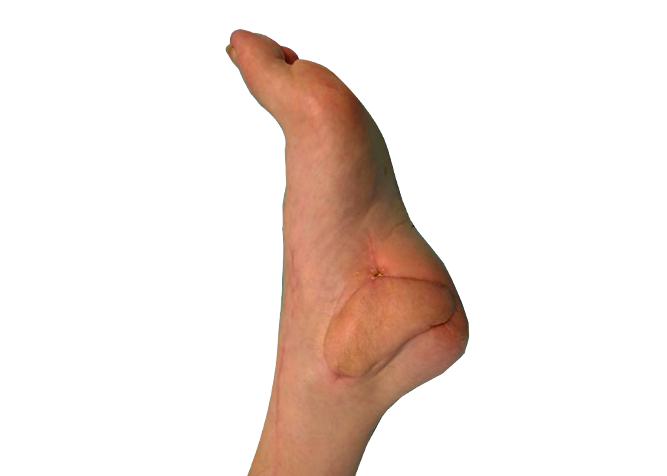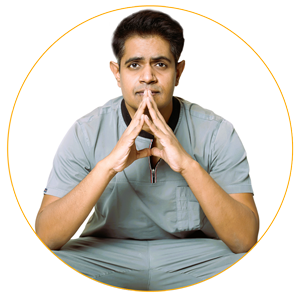Diabetic Foot Surgery
Diabetic Foot is any foot pathology that is a result of any chronic complication of Diabetes.

Best Diabetic Foot Surgery in India
Diabetic Foot is any foot pathology that is a result of any chronic complication of Diabetes.
In diabetes, the blood glucose levels are too high, which is also called high blood sugar. If these levels stay high for a longer period, they can damage the nerves and blood vessels of the foot. Sometimes due to peripheral nerve dysfunction, you lose the sensation in your feet. You stop feeling any soreness, cut, or blister. These minor injuries may also remain undiscovered for a long time which further causes infection. This infection if goes untreated leads to the spread of infection and the formation of ulcers. Due to the damage or blockage of the blood vessels in diabetes, the blood and oxygen supply of the feet is decreased due to which the ulcers don't heal.
Sometimes the condition becomes so serious that it may also lead to Amputation.
If you visit Dr. Amit Agarwal for the consultation on diabetic foot, he will evaluate your condition with the help of some tests such as
- Doppler (to see arterial blockade)
- and X-rays (to rule out osteomyelitis) and the treatment will be decided accordingly.
- Blood test, ECG, ECHO, and Chest X-ray to rule out any co-existing diseases of heart, lung, and kidney.
Complications related to Diabetic Foot include
Some complications require immediate attention and have serious ongoing effects on the foot which a Plastic surgeon should see and monitor closely.
These complications include:
- Infections and abscesses
- Foot deformity
- Wound or foot ulcers that do not heal
- Gangrene
- Charcot's Foot alters the shape of the feet as the bones in the toe and foot break or shift.
These complications can sometimes be reversed by a Plastic Surgeon such as infections but in some cases like Gangrene, it may lead to permanent physical change.
What is the TREATMENT OF DIABETIC FOOT?
Treatment of Diabetic Foot usually varies with the severity of the condition which will be evaluated when you will visit Dr. Amit Agarwal. Diabetic Foot can occur because of all the reasons mentioned above or can be due to any one of them. So, the treatment can be both Non-Surgical and Surgical depending on the condition of the diabetic foot. The management will be classified as Non-Surgical or Surgical which includes:
Non-Surgical Treatment
Non-surgical treatment includes:
- Keeping the wounds clean and dressed.
- Antibiotics, minimum painkillers, and a few injectables if required.
- Immobilization devices can be worn like cast Boot.
- Closely observe the toe and foot for any progression of infection and gangrene of toes.
- Timely treatment of any corn or callosity of foot region.
- Proper control of blood sugar.
Surgical Treatment
When the Non-Surgical treatment cannot heal the Diabetic Foot problem successfully, then the considerable option is Surgery. Surgical options are decided on the severity of the condition.
In many cases, diabetic foot surgery is not a single surgical procedure, but it may take multiple surgeries to cure the condition to an extent. Here, we try to save the foot from amputation using procedures and surgeries to reconstruct the foot and rehabilitate the patients back into society.
So, surgical procedures can be divided into 4 stages:
- Stage 1 - Debridement of dead and deadly tissues from the foot and leg.
- Stage 2 - Skin grafting - Once the wound is healthy, skin grafting may be done if the defect is not much deep and vitals structures are embedded in granulation tissue.
- Stage 3 - Local Flap Reconstruction/Microvascular Free Flaps - which is usually done when any critical part of the limb is exposed like bones, tendons, and joints and it becomes really important to preserve them for the normal functioning of the limb. A well-blood-supplied tissue is taken from the adjacent area or from other areas of the body to cover the part of the limb with it.
- Stage 4 – Amputation - usually this condition occurs when the severity is to the fullest and the main motive becomes to save the life of the patient. Amputation can be a toe, forefoot amputation, midfoot, or below knee amputation depending on the part of the limb that is needed to be removed.
What are the different surgeries done for Diabetic foot?
- Debridement - Debridement is the thorough cleaning of the wound and removing unhealthy infected and dead tissues from the wound. After debridement, Negative Pressure Wound Therapy (VAC) before the definite procedure is done to reduce the toxins and infection in the body.
- Fasciotomy – If the patient presents with rapidly increasing swelling, redness, or pain of the leg and foot, and even after antibiotic treatment it does not subside, it can lead to compartment syndrome (increased pressure in the muscle compartment). This is an emergency condition and urgent Fasciotomy is required to relieve the pressure otherwise it can lead to gangrene of the limb and severe sepsis in the whole body.
- Skin grafting - Skin grafting is the transfer of a thin sheet of skin, usually taken from the thigh, to cover the raw areas of the leg and foot region. Once the wound is healthy, skin grafting may be done if the defect is not much deep and vital structures are embedded in granulation tissue. In such cases, dressing is done every alternate day after surgery. Patients may be discharged after 5-6 days, and regular follow-up is required. The area gradually heals and needs a compression garment later to avoid hypertrophy of scars and to reduce swelling.
- Local Flaps - The local flap is the transfer of the flap of skin from the surrounding areas to the defect site. It is done when the defect is deep, and the surrounding area is normal and sufficient enough to cover the defect. If not, or the local flap fails, then a flap taken from other parts of the body is used to cover the defect through microvascular reconstruction.
- Microvascular reconstruction - If the defect is deep and any vital structure is visible & exposed, like a blood vessel, nerve, bone, or tendons exposed, then the transfer of skin flap or muscle flap from a distant area as a free flap is done to cover the defect using microsurgical techniques. It needs surgical expertise and a good working team. Dr. Amit Agarwal specializes in diabetic foot microsurgical reconstruction and has saved innumerable feet and legs from amputation.
After the wound area has settled, there may be a raw area, or defect, which needs to be covered either by skin grafting, local flaps, or free flaps (microsurgical reconstruction).
In this, we give incisions over the leg and foot such that pus, excess fluids, and toxins are drained without disturbing the blood supply of the limb. In cases of large and dirty wounds, debridement is done along with fasciotomy. The patient may require furthermore debridement to remove the unhealthy portion in the wound. After this, regular dressings are done daily.
After initial fasciotomy and debridement, Negative Pressure Wound Therapy (VAC) before the definite procedure is done to reduce the toxins and infection in the body. /
A definite Procedure to close the wound is done last which may be skin grafting, local or free flaps as per the requirement.
The flap should be monitored frequently post-surgery. Hospital stay is increased, concerning skin grafting or local flap procedures, but it is the best modality to cover the defects in diabetic foot patients. The dressing is done every alternate day and the patient is admitted for at least 7-8 days and discharged once the flap is settled.
The success rate of diabetic foot reconstruction is quite good around 80%- 90% in hands of Dr. Amit Agarwal. It means 80-90 out of 100 feet are saved from amputation. The results of microsurgical reconstruction in the diabetic foot can be quite unpredictable as it depends on multiple factors like the status of blood vessels, level of immunity of the patient, his/ her health status, and protein level to withstand the procedure.
All these surgical techniques are helpful at appropriate times, depending on the type of infection. Post-surgical management is equally important for the overall outcome of the treatment.
After the surgery, the patient is bedridden for 2-3 weeks. No ambulation is advised, and the limb has to be elevated by using pillows underneath. After several dressings, when the operated site is completely stable, the patient is given a pressure garment and ambulation is started.
Amputation
In untreated cases or neglected cases of diabetic foot, gangrene may occur, and infection may lead to toxemia and septicemia i.e, the release of toxins in the body by infectious organisms. Amputation may be required in such cases. In worst cases, even lead to death.
If a patient fails to reach the appropriate hospital or doctor for management of such cases on time, or due to other comorbidities, which decrease the immunity of the body, delay in healing occurs and infection spread much more quickly. In this scenario, the patient might require amputation, which means it becomes imperative to remove the affected portion of the foot or leg from the body.
In peripheral artery disease, the probability of amputation within one year after the first ulcer or gangrene is 34.1% and the death rate has been reported to be 5.5%.
There are various indications for amputation in diabetics:
- Viability of part is destroyed by injury or disease – dead limb.
- The life of the patient is at risk of the spread of a local infection - a deadly limb.
- Patients may be better served by an artificial limb because of deformity or paralysis - a deformed limb.
- Dying limb – acutely ischemic limb (sudden onset of black discoloration of limb), late presentation.
The level of amputation depends not only upon the extent of the disease but also the functionality desired in the remaining stump.
Post amputation when the stump is completely settled, after about 2-3 months period, the prosthetic limb is advised.
Know your surgeon better

Best plastic surgeon, Dr. Amit Agarwal is an American Board Certified, extensively trained, and best Plastic & Aesthetic surgeon in Lucknow. He is the Chief Plastic Surgeon heading the Department of Plastic, Microvascular, and Craniofacial surgery at Vivekananda Polyclinic and Institute of Medical Sciences, Lucknow, U.P, India. He maintains a busy practice at Avadh and Nishat Hospital and his own center - Kayakriti Plastic Surgery & Dental Center. He was formerly a Consultant in the Department of Plastic Surgery and Burns at the prestigious SGPGI, Lucknow.
MS, DNB (General Surgery) MCh, DNB (Plastic Surgery),
MNAMS, FACS, FICS, FRCS (Edinburgh, UK)
His Credentials
Three pillars of kayakriti
Privacy
We believe your experience with us should be comfortable and hassle-free to make it one of your best lifetime experiences for yours. We, here at the clinic, take full precautions to maintain your privacy in any manner. We also provide a staff who will receive you from the gate and take you to the chamber directly if you demand.
Trust
Our Surgeon is highly qualified and internationally certified with a team of skilled staff to perform any surgical or non-surgical treatment on your body.
Safety
When you plan to undergo any surgery you should always keep in mind that it's your body and it's a surgery. We, here always keep your safety a priority and will never recommend you to undergo any such procedure which is not safe for you. We also provide you with a detailed description of the complications which may occur after the surgery during the consultation as it's a surgical procedure so there may be some complications depending on the way your body reacts.
Kayakriti in news



Frequently Asked Questions
If you have flat or small breast and you want to improve your breast and hip contour ratio then you are a good candidate for it. The answer will be best provided after the first consultation with Dr Amit Agarwal.
Acute pain will be there for almost a week which gradually reduces and there will be soreness and swelling which may take up to 3 weeks to subside.
You can join your work and daily routines after a week of the procedure and can start exercising after 3 weeks of it.
Yes, you have to wear it round the clock unless we suggest you to remove it.
This surgery does not affect the ducts or the areas of the breast involved in milk production. Thus, it does not affect the breast feeding.
This surgery does not affect the ducts or the areas of the breast involved in milk production. Thus, it does not affect the breast feeding.












Kayakriti Plastic Surgery & Dental Center
D-43, Near Punjab National Bank, Rajajipuram, Lucknow, Uttar Pradesh - 226017, India
Phone No. +919695940009, +919695940006
Map Location





























Social Media Presence